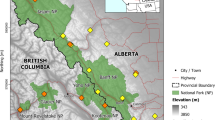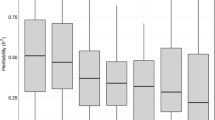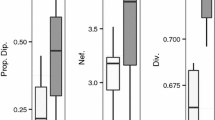Abstract
We used a population biological approach to assist our understanding of the evolution of behaviour, with island bumblebees as our model system. The widespread European species Bombus terrestris occurs on all major Mediterranean, and some Atlantic islands. Bees from different populations differ in a variety of behavioural traits, including floral colour preferences, flower detection, and learning behaviour. We attempted to correlate these behavioural differences with each population’s environment, but could not find straightforward adaptive explanations. We also performed reciprocal transplant studies to compare nectar foraging performance of bees from three different populations, but found that non-native bees consistently outcompeted native bees. Thus, we consider genetic drift, exaptation, and pleiotropy as possible alternative explanations to a strictly adaptive explanation for between population behavioural differences in bumblebees.









Similar content being viewed by others
References
Adkison MD (1995) Population differentiation in Pacific salmon: local adaptation, genetic drift, or the environment. Can J Fish Aquat Sci 52:2762–2777
Banschbach VS (1994) Colour association influences honey bee choice between sucrose concentrations. J Comp Physiol A 175:107–114
Barton NH (1984) Genetic revolutions, founder effects and speciation. Annu Rev Ecol Syst 15:133–164
Barton NH (1998) Natural selection and random genetic drift as causes of evolution on islands. In: Grant PR (ed) Evolution on islands. Oxford University Press, Oxford, pp 102–123
Briscoe AD, Chittka L (2001) The evolution of color vision in insects. Annu Rev Entomol 46:471–510
Brown JH, Lomolino MV (1998) Biogeography. Sinauer, Sunderland
Chittka L, Reinhold H (1999) Towards an individual-based approach to insect learning. In: Elsner N, Eysel U (eds) Proceedings of the 27th Göttingen neurobiology conference. Thieme, Berlin, p 257
Chittka L, Thomson JD (1997) Sensori-motor learning and its relevance for task specialization in bumble bees. Behav Ecol Sociobiol 41:385–398
Chittka L, Wells H (2004) Color vision in bees: mechanisms, ecology and evolution. In: Prete F (ed) How simple nervous systems create complex perceptual worlds. MIT, Boston, pp 165–191
Chittka L, Thomson JD, Waser NM (1999) Flower constancy, insect psychology, and plant evolution. Naturwissenschaften 86:361–377
Chittka L, Spaethe J, Schmidt A, Hickelsberger A (2001) Adaptation, constraint, and chance in the evolution of flower color and pollinator color vision. In: Chittka L, Thomson JD (eds) Cognitive ecology of pollination. Cambridge University Press, Cambridge, pp 106–126
Dafni A, Bernhardt P, Shmida A, Ivri Y, Greenbaum S, O’Toole C, Losito L (1990) Red bowl-shaped flowers: convergence for beetle pollination in the Mediterranean region. Isr J Bot 39:81–92
DeJonghe R (1986) Crossing experiments with Bombus terrestris terrestris (Linnaeus 1758) and Bombus terrestris xanthopus (Kriechbaumer 1870) and some notes on diapause and nosemose (Nosema) (Hymenoptera, Apoidea). Phegea 14:19–23
Dornhaus A, Chittka L (2004) Why do honeybees dance. Behav Ecol Sociobiol 55:395–401
Dukas R, Morse DH (2003) Crab spiders affect flower visitation by bees. Oikos 101:157–163
Estoup A, Solignac M, Cornuet J-M, Goudet J, Scholl A (1996) Genetic differentiation of continental and island populations of Bombus terrestris(Hymenoptera: Apidae) in Europe. Mol Ecol 5:19–31
Ford EB (1955) Rapid evolution and the conditions which make it possible. Cold Spring Harb Symp Quant Biol 20:230–238
Foster JB (1964) The evolution of mammals on islands. Nature 202:234–235
Giurfa M, Núñez J, Chittka L, Menzel R (1995) Colour preferences of flower-naive honeybees. J Comp Physiol A 177:247–259
Goulson D, Peat J, Stout JC, Tucker J, Darwill B, Derwent LC, Hughes WOH (2002) Can alloethism in workers of the bumblebee, Bombus terrestris, be explained in terms of foraging efficiency? Anim Behav 64:123–130
Gumbert A, Kunze J, Chittka L (1999) Floral colour diversity in plant communities, bee colour space and a null model. Proc R Soc London B 266:1711–1716
Heinrich B (1979) Bumblebee economics. Harvard University Press, Cambridge
Heinrich B, Mudge PR, Deringis PG (1977) Laboratory analysis of flower constancy in foraging bumblebees: Bombus ternarius and B. terricola. Behav Ecol Sociobiol 2:247–265
Jander U, Jander R (2002) Allometry and resolution of bee eyes (Apoidea). Arthropod Struct Dev 30:179–193
Menzel R, Shmida A (1993) The ecology of flower colours and the natural colour vision of insect pollinators: the Israeli flora as a study case. Biol Rev 68:81–120
Olesen JM (1985) The Macaronesian bird-flower elements and its relation to bird and bee opportunists. Bot J Linn Soc 91:395–414
Palmer M (2002) Testing the ’Island Rule’ for a tenebrionid beetle (Coleoptera Tenebrionidae). J Ecol 223:103–107
Plowright RC, Owen RE (1980) The evolutionary significance of bumble bee color patterns: a mimetic interpretation. Evolution 34:622–637
Schikora J (2001) Blütenfarben auf Mittelmeerinseln und die Rolle von genetischer Drift bei den Farbpräferenzen von Hummeln: “Zoologie II.” Julius-Maximilians-Universität, Würzburg
Schikora J, Spaethe J, Brockman A, Chittka L (2002) Colour vision and colour preference in Bombus terrestris: a population biological approach. Zoology 105:28
Smith C, Barber I, Wooton RJ, Chittka L (2004) A receiver bias in the origin of threespine stickleback mate choice. Proc R Soc London B 271:949–955
Spaethe J, Chittka L (2003) Interindividual variation of eye optics and single object resolution in bumblebees. J Exp Biol 206:3447–3453
Spaethe J, Weidenmüller A (2002) Size variation and foraging rate in bumblebees (Bombus terrestris). Insect Soc 49:142–146
Spaethe J, Tautz J, Chittka L (2001) Visual constraints in foraging bumblebees: flower size and color affect search time and flight behavior. Proc Nat Acad Sci USA 98:3898–3903
Stanton ML, Galen C (1997) Life on the edge: adaptation versus environmentally mediated gene flow in the snow buttercup, Ranunculus adoneus. Am Nat 150:143–178
Stüber K (2002) Sammel- und Flugverhalten bei Hummeln: ein Vergleich zwischen Populationen. University of Würzburg, Würzburg
Vogel S, Westerkamp C, Thiel B, Gessner K (1984) Ornithophilie auf den Canarischen Inseln. Plant Syst Evol 146:225–248
Widmer A, Schmid-Hempel P, Estoup A, Scholl A (1998) Population genetic structure and colonization history of Bombus terrestris s.I. (Hymenoptera: Apidae) from the Canary Islands and Madeira. Heredity 81:563–572
Acknowledgements
The research was supported by grants Ch147/3-1 from the DFG, and NER/A/S/2003/00469 from NERC. Part of this work was performed under the auspices of the University of Würzburg, Germany. We wish to thank Parul Desai, Adrienne Gerber-Kurz, Anja Hickelsberger, Margaret Lancaster, Pritesh Patel, Tonia Schamberger, Juliette Schikora, Ronnie Singh, Johannes Spaethe and Kristina Stüber for discussions and help with the experiments, and R.B. Lotto for Fig. 1.
Author information
Authors and Affiliations
Corresponding author
Rights and permissions
About this article
Cite this article
Chittka, L., Ings, T.C. & Raine, N.E. Chance and adaptation in the evolution of island bumblebee behaviour. Popul Ecol 46, 243–251 (2004). https://doi.org/10.1007/s10144-004-0180-1
Received:
Accepted:
Published:
Issue Date:
DOI: https://doi.org/10.1007/s10144-004-0180-1




